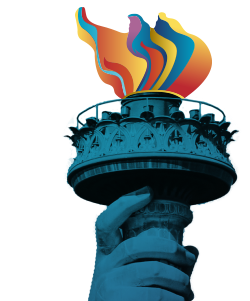Art Spiegelman was born in post-World War II Stockholm, Sweden, to Polish Jewish parents who survived the Auschwitz concentration camp. Most of his family, including his brother — his parents’ only other child — perished during the war. Spiegelman came to the United States in 1950, and one of his memories of their arrival by ship was of being perched on his father’s shoulders at two years old as his father “excitedly pointed at the giant lady standing in the water to welcome us to New York.”
After living briefly in Pennsylvania, his family settled in Queens, New York. Spiegelman’s artistic talents were recognized early on, and he began cartooning professionally as a teenager. Spiegelman went on to study art and philosophy at Harpur College (now Binghamton University) in New York, but dropped out after his mother committed suicide.
Spiegelman was an influential figure in the underground comix subculture of the 1960s and 1970s. During his more than two decades with Topps Bubble Gum Co., Spiegelman created the witty and iconic trading card series Wacky Packages and Garbage Pail Kids. Along with Bill Griffith, Spiegelman was the creator and editor of the 1970s magazine-sized comics anthology Arcade.
In 1980, Spiegelman and his wife, the French-born designer Françoise Mouly, founded the avant-garde comics magazine RAW. Maus, Spiegelman’s meticulously researched exploration of his parents’ Holocaust experience, in which he depicts Jews as mice and Nazis as cats, was serialized in RAW from 1980 to 1991. It was also published in collected volumes by Pantheon. Maus is not only Spiegelman’s best-known work, but was transformative for comic art because of the unprecedented critical acclaim for what was then an underappreciated art form, and for its profound influence in exploring the trauma of the Holocaust in popular culture. The Wall Street Journal considered it “the most affecting and successful narrative ever done about the Holocaust” while the New Yorker called it “the first masterpiece in comic book history.” In 1992, the Pulitzer Prizes awarded Spiegelman a Special Citation for Maus, the first such honor for a cartoon artist.
In Maus II: A Survivor's Tale, serialized in the early 1990s, Spiegelman focused on his parents’ postwar time in Europe and immigrant lives in America.
At the New Yorker, where he was a staff artist and writer from 1993 to 2003, Spiegelman created some of the magazine’s most iconic covers, including his and Mouly’s black-on-black portrayal of the Twin Towers in the issue following the 9/11 attacks. Spiegelman left the New Yorker to work on the broadsheet-sized color comic In the Shadow of No Towers, which explores his and his family’s experience as New Yorkers witnessing the attacks and their political aftermath. The work first ran in European publications and was later published as a book in the United States. In 2014, the New York Times selected In the Shadow of No Towers as one of the “100 Notable Books of the Year.”
Spiegelman’s work has been featured in numerous exhibitions, including several major retrospectives, worldwide. Spiegelman’s awards include the Grand Prix, the Edward MacDowell Medal, and a Guggenheim fellowship. He was named to the Art Directors Club Hall of Fame and was made an Officier de l’Ordre des Arts et des Lettres, one of France’s highest civilian honors.
Spiegelman has been vocal about the importance of the United States remaining a refuge for those fleeing persecution, a vision captured by Emma Lazarus in her famous sonnet "The New Colossus," which his mother recited to him as a child. In 1903, the poem was inscribed on a plaque and placed on an inner wall of the pedestal of the Statue of Liberty, the "giant lady" that had first welcomed Spiegelman to America. In Lazarus's words, Lady Liberty exhorts the world: “Give me your tired, your poor / Your huddled masses yearning to breathe free.”







